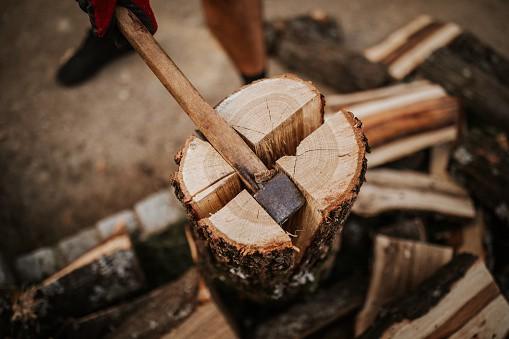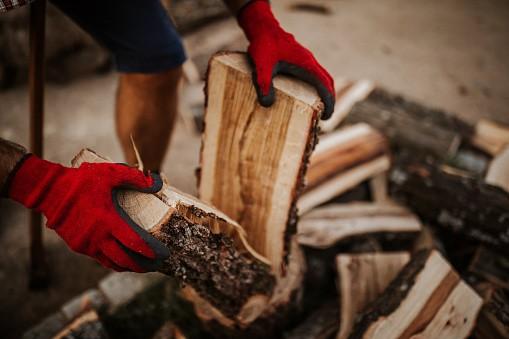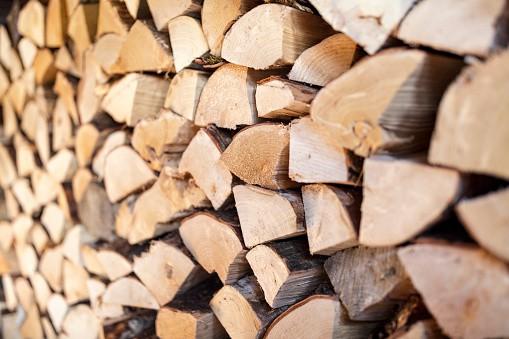The physical properties of hardwood are different from those of softwood. Therefore, you need to be well conversant with the properties and use the correct technique to split firewood. Unlike softwood, hardwood is tough with some species featuring interlocking grains and others naturally designed to resist splitting. Such characteristics make hardwood extremely hard to split. However, with the right information on how to split hardwood for firewood, the process should not pose any problems.

Reasons For Splitting Wood
Why would you want to split hardwood for firewood? In most cases, hardwood is extremely valued in making luxurious furniture, building boats, making musical instruments, flooring, and making barrels. However, they also form good sources of firewood for fuel and cooking. They burn for longer and produce strong, clean fire.
Usually, logs destined to be used as firewood are usually too large in diameter to season well and/or fit the firebox or wood stove such wood is intended for. Splitting is the most efficient and convenient way to make such large diameter logs usable and to allow them to season quickly. Contrary to the traditional belief that any bulky linebackers swinging a splitting maul uncontrollably can split hardwood firewood. However, just anyone with scrawny arms and the right technique can split even the hardest hardwood quicker and more efficiently.
What Will You Need?
The success of any undertaking depends on the level of preparation of the undertaker. The analogy is the same when it comes to splitting hardwood firewood. In order to set yourself up for success, you must make available all the tools you will use. Here are the things you need to collect:
1. A Splitting Maul
- Go for a sharp splitting maul that is not too small or too heavy for you.
2. Metal Splitting Wedges
- These may become important especially for longs that are knotty
3. A Saw and a Saw Buck
- You will need these to cut large logs into shorter ones that can fit your firebox or wood stove
4. Dry Hardwood Logs
Dry logs are easier to split
5. A Stub/Chopping Block
Something to put under the log or the surface on which to place the log during splitting so your log does not hit the ground if you miss
6. Sledgehammer
Necessary for releasing stuck maul or hitting wedges
7. Safety Gear
To prevent injuries, make ready safety goggles, a home First Aid Kit, rubber hand gloves, and solid work boots (preferably steel-toe). You should have a friend.

General Tips On Splitting Firewood
Some tips on splitting logs and cutting wood include:
1. Cut Wood to Size
Standard wood stoves and fireplaces usually take firewood pieces measuring between 40cm and 50 cm (or 16 inches and 20 inches) in length. Besides, shorter hardwood logs will split much easier. The determining factors for the suitable length include storage and handling, and the intended application. You can make use of a saw for this purpose. Use a measuring tape if necessary to ensure you make accurate cuts.
When cutting, try as much as possible to cut the ends of each piece flat and square as you will need to stand them on end on your stub or chopping block to split them. Crooked and misshapen cuts will only serve to frustrate the task of standing the longs and even aiming.
2. Set Up A Chopping Block Or Stub
The worst mistake you can ever do is to slip firewood from the ground. Doing so will cause serious strain on your back with catastrophic outcomes in your posture and general health. It is also extremely hard and split firewood from the ground as you will use excessive energy. A good technique is to place the log on a raised surface.
Experts recommend a surface that is about six inches off the ground. However, you can choose a surface height that you are comfortable with. A good way to raise such a surface is to use a chopping block or a stub.
Just ensure the surface is neither too short nor too high to prevent dangerous ricochets in the case of a glancing blow. The best and safest material for the chopping block is wood, preferentially a large section of a tree trunk.
3. Put Your Safety First
Although splitting hardwood firewood is not so dangerous, carelessness and failure to observe some safety precautions can land you in big trouble. Always wear protective gear before you begin the process. Hardwood splinters are needle-sharp and the force of an ax can set them into motion and convert them to projectiles that can cause severe injury. Using poor-quality shoes may not stop the maul from cutting your legs in case of a missed hit.
4. Choose the Right Location
Pick a safe location to do your splitting. Allow for right footing and ensure the area is clear of any debris and there are no hanging branches overhead. The place should also be far from glass windows and other delicate installations. It would be good to perform the task on a cold day. Properly dried and seasoned hardwood firewood will pop right apart on a cold day making your work much easier. Working warm on a hot day will exhaust you faster and interfere with your productivity.
Methods Of Splitting Hardwood Firewood
Two methods can help you in splitting hardwood firewood. The first method involves the use of splitting maul. The second method uses splitting wedges. Using the correct technique with either of these two methods will guarantee you reliable results. We will describe each of these methods subsequently.
Method 1: Splitting Hardwood Firewood with a Maul
Splitting maul is designed to do just that – split wood. This way, they form the best tools for splitting clean, less knotty logs. Here are the steps to follow, for a successful splitting job:
Step 1: Put Your First Log on Your Chopping Surface
I always love to start with a straight, squarely cut log to put me on the course of a successful job. No matter your style, ensure you place your first log on the chopping block or stub centrally and in a stable manner. Consider what may happen if you hit an unstable long. It may lead to a glancing blow which could strike your leg causing serious injuries or as well send the wood flying like a projectile to damage surrounding installations or hit pets or other persons in the vicinity of your working area.
Step 2: Inspect the Log
A clever technique that would guarantee faster and successful splitting of hardwoods is to inspect the log first before aiming and striking it. Take a keen interest in the hairline cracks present on the cut surface of the logs. The cracks will help you while aiming so your run your maul in the direction of the cracks.
Keep in mind that different species of hardwood split differently, therefore you must plan accordingly. For instance, oak wood splits easily via its center regardless of its diameter. Maple tree, on the other hand, tends to split easily toward the edges of the end-grain/
Besides the hairline cracks, look for areas where limb was removed or areas with large knots when the wood was cut and avoid them. Such places are extremely difficult to navigate and will take you a lot of time to surpass.
Step 3: Make an Aim
It is a good technique to aim before you swing that splitting maul. Choose the location where you want to split the wood be it a hairline crack or any other weak point. Stand stably with your maul resting on that place and set your feet squarely.
It might be a good idea to tap an indentation into the surface of the wood. This will give you a good visual cue at which you guide your splitting maul in case the grains are not readily visible from your standpoint.
Step 4: Bring the Maul Up/Down
Contrary to what many people think, you do not need to swing a maul to split wood. In other words, you do not need to put the end of your maul behind your head to split hardwood properly. Hold the maul’s distal handle firmly with your non-dominant hand, and cradle it with your writing hand, just below the head. Follow this by flexing your knees only slightly and then lifting the head of the maul right up just above your head while extending your arms straight.
Slide your dominant hand to approximate your other hand, grip the end of the handle, bring your hands down as you flicked your wrist, and then let gravity take over. Keep in mind that the success of wood splitting has very little to do with strength but everything to do with the technique you have employed.
Step 5: Repeat Step 4 Until All Wood Is Done
In your next steps, try striking the initial place or along the crack created by the first strike if the wood did not split right away. Do this until you split logs and get done with a piece of wood.
Step 6: Continue Splitting and Then Stack
Continue with log splitting into progressively smaller pieces until all the wood is done. A good practice would be to start by splitting the log into half and then each of those halves into their halves until you achieve pieces of the desired size. You should aim at achieving sizes of about between 6 to 8 inches or 15 to 20 cm in the largest cross-section.
Stack the split pieces of hardwood carefully to allow them to season thoroughly before you can use them for the intended application. Cover the stacked wood with a waterproof material to prevent rain from wetting it over and over causing it to rot. You must do that in a manner that encourages good air circulation. You can also use an electric log splitter considering wood heat.

Method 2: Splitting Hardwood with Splitting Wedges
While the golden method for splitting hardwood is using a splitting maul, certain wood types only pop apart if you use a splitting wedge. You will need several wedges if you are dealing with extremely knotty wood pieces. The large-diameter or very hardwoods may not yield easily to splitting mauls. Here are the steps to follow to split hardwood with wedges:
Step 1: Have a Number of Wedges
It is often possible to drive a wedge all the way into a log without necessarily splitting it. This means you must have not one but many wedges at hand before you begin your splitting for backup. I would advise that you have in your collection a sharper wedge known as a starter wedge. It will allow you to bite into the wood and get your splitting started. You should also have a blunter but wider one to help you continue with splitting once you have gotten started.
Step 2: Tap the Starter Wedge into Your First Log
Use your short handle sled hammer to drive the started wedge into the grain of the first log. However, you can use any sled that is available for the job. Just hold the wedge-like you will do for a large nail and then tap it until it can stand without your help.
Step 3: Hammer the Wedges with the Sledge
Employ straight and solid blows to hammer the wedge into the log along the grain until the pieces pop apart. In case you hammer the wedge all the way in and the log fails to split then use another wedge along the original crack but much closer to the edge of the wood. This way, the wood splits longer thus breaking free both wedges for further use.
For your own safety, please stand clear of the line of crack to prevent any chances of the wedge popping out at your feet and predisposing you to a nasty accident. Furthermore, you have to ensure you stand perpendicular to the splitting log and the wedge itself when hammering.
Step 4: Finish Up
It is common for hardwood to remain connected via wood fibers after splitting with wedges. Should that happen, use an appropriate splitting maul head or ax to split such sections into smaller pieces that are easy to manage. Avoid any temptations to use wedges to finish up as this could increase chances of smaller dangerously popping out and flailing loose.
Safety Tips For Splitting Hardwood Firewood
Congratulations, you have just learned two straightforward methods you can use to split hardwood firewood. However, you must also keep a few safety tips to ensure the process is smooth, successful, and free of any episodes. Here are the important tips:
- Do not use an ax to split hardwood firewood. Its narrow head will definitely stick in the wood grains. Using the right tools is essential to get done with pieces of wood easily.
- Use safety glasses, high-quality hand gloves, steel toe boots, and well-fitting clothing.
- Always stand with your feet apart, not together to avoid hitting your legs in case of a glancing blow.
- Do not split hardwood firewood alone. Have a friend who can perform First Aid and call for help in the case of an accident. The friend must be at least 10 feet away.
- Your working areas should be clear and free of debris and overhanging tree limbs. Ensure you stand on a level ground.
- To avoid overexertion and use of more energy, make sure the splitting axe is sharp.
Conclusion
Splitting hardwood firewood has never been easier. Do not believe the myth that hardwood is tough and difficult to split and that you need to have powerful muscles to achieve any good results. The truth is that it all depends on your technique. As you have learned from this resourceful discussion, a splitting maul does is the premium tool for the job but you can also use splitting wedges. If you follow every step and tip, you will split all your hardwood firewood faster and more efficiently.
